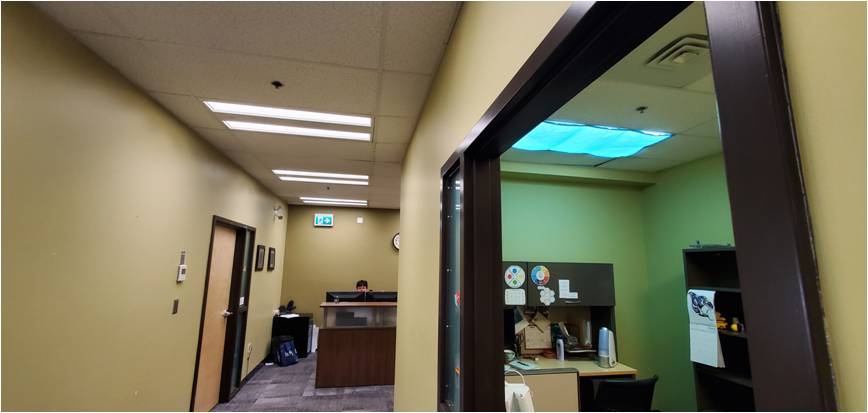Today, commercial and institutional facility managers are dealing with a lot of complaints from occupants about indoor lighting being too bright. Approximately 15% of people are sensitive to light (photophobia) due to various issues such as migraines, dry eyes, post-concussion syndrome, ADHD…etc. Is it any wonder as we spend most of our days looking at computers.

“Half of the human brain is devoted directly or indirectly to vision” – (MIT Research – Brain Processing of Visual Information; ProfessorMriganka Sur of MIT’s Department of Brain and Cognitive Sciences)

Lighting that is too bright and glary can cause everything from mild irritation to complete impairment, hampering the ability to work and learn. Occupants are desperate to implement measures to reduce light output and are resorting to primitive means such as disconnecting lights or using full light covers or both.

Even though good solutions exist, the focus for lighting upgrades has been primarily on saving power and maintenance dollars.
How much time, expense and energy is being spent to create work environments that look like these?

In classrooms we are witnessing teachers working around their existing lighting to the point of spending their own money and time to purchase and install supplemental “solutions”. They are buying floor lamps, pendants, track lights, and patio lights. There are students and teachers who likewise suffer from light sensitivity, but there is also utility in providing a warm and relaxing environment to calm children which is why they do this.

Teachers use warm dim lighting to regain attention when the kids are too excited such as coming back from recess or to settle down reading time. In these examples lighting is used as a tool to queue a desired behaviour. When work is to be done, teachers will return to the existing cool bright lighting. Dynamic lighting allows teachers to accomplish their tasks more effectively and allows kids to be better students.

Many of our older commercial and institutional buildings contain legacy fluorescent or first-generation LED lighting that is failing at an accelerated rate. When it comes time to retrofit the old lights, two problems exist. Facility managers often do not know that affordable LED lighting control systems are available which offer dynamic color and brightness along with motion sensing and manual controls.

If these facility managers are aware, they are reluctant to take a chance on new technology or they cannot provide a good argument to management for spending more than the lowest cost option. It is understandable that the perceived low risk decision is to simply replace the old fluorescents bulbs with new LED bulbs that look similar while providing a small benefit in energy savings. Unfortunately, this is a trap, and it becomes the high-risk option. I will explain why.

Our lighting systems today continue to look like the past 85 years. They deliver one color of white with one brightness level and no manual controls for adjustment.

T8 retrofit LED bulbs (below) and LED flat panel fixtures (picture below) are popular choices for office and classroom retrofits because they are the cheap option. The drawback is that they are restricted to one color, one brightness, are non-dimmable and have no manual controls.
The teacher in the picture below has no way of adjusting lights

Good options do exist that provide affordable solutions to these problems. Lights may be manually controlled from switches, remotes, or smart phones. They can be adjusted anywhere from very warm white to very cool white, from very dim to very bright. These include low glare and built in motion and daylight sensing as well as offering manual controls.

In the pictures above and below, old fluorescent fixtures were retrofitted with low glare dynamic wireless controllable LED. The installation took approx 10-15 mins per fixture.
Today, dynamic LED lighting and control solutions can be installed simply and affordably. They are rapidly becoming the new standard. Facilities caught in the lowest cost retrofit trap may find themselves being pressured to upgrade yet again in the near future, while their occupants continue to suffer.

Lights may be dimmed or color of white may be changed with manual controls. Lights also dim and shut off automatically when the space is vacant.
Companies and institutions spend significant capital trying to attract and retain workers. Employers continually strive to attain the highest productivity. This is the measure of dollars-invested in all expenses (buildings, people, technology, etc…) to dollars-gained through sales of services and/or products. In the case of education, you can consider student grades to be the measure of productivity. After all higher grades generally result in higher paying jobs and greater innovation and economic output.

In the picture above, old fluorescents were retrofitted from below the ceiling with dynamic wireless controllable LED.

In the picture above, lights on the left were retrofitted with low glare dynamic wireless controllable LED. The office on the right is about to be retrofitted.
If you are impaired from being the most productive in your workplace, what are the outcomes ? Your productivity suffers, your health may suffer, you may choose to be absent more often, or you may quit altogether. If you consider a student, their grades and behavior may suffer.
If you consider these factors along with all the time and money wasted on inadequate partial remediation efforts, the actual solution becomes the low-cost option.



